Open Journal of Geology
Vol. 2 No. 1 (2012) , Article ID: 16742 , 9 pages DOI:10.4236/ojg.2012.21003
The Geological, Petrographical and Engineering Properties of Rhyolitic Tuffs (Çan Stone) in Çan-Etili Area (Çanakkale), NW Turkey: Their Usage as Building and Covering Stones
Department of Geological Engineering, Canakkale Onsekiz Mart University, Canakkale, Turkey
Email: o_turkdonmez@comu.edu.tr
Received October 14, 2011; revised November 17, 2011; accepted December 22, 2011
Keywords: Çanakkale; Çan Stone; Tuff; Building Stone; Covering Stone
ABSTRACT
In this study, the geological, petrographical properties of rhyolitic tuffs exposed around Çan-Etili in the Biga Peninsula (NW Turkey) which are pyroclastic products of Late Oligocene-Early Miocene aged Çan Volcanism were investigated, also physical and mechanical characteristics of tuffs introduced and tried to determine the impact on engineering properties of petrographical features. In the region, rhyolitic tuffs called locally “Çan stone” have been used as covering and building stones for many years. These tuffs generally have light yellowish, beige, brown colored and different patterns with light yellowish, cream, reddish and brown colors caused by iron oxidation of hydrothermal alteration. They are preferred as coatings and decorative stone with these patterns. Çan stone which consisted of rhyolitic composition, lithic and locally crystalline tuffs has compact structure. The mineral assemblage of tuffs is mainly composed of quartz, plagioclase, rarely biotite, amphibole (hornblende) phenocrystals and opaque mineral with particles of volcanic glass and lithic fragments. Not only petrographical and geochemical analyses were carried out but also standard rock mechanic tests (unit weight, specific gravity, porosity, water absorption and uniaxial compressive strength) on rhyolitic tuffs samples collected from four different quarries (Hoppa Hill, Halilaga, Uzunalan, Dereoba). Simple regression analysis of test results obtained from four different regions and correlations were found good correlation between engineering properties and the petrographical and chemical properties of rhyolitic tuffs.
1. Introduction
Biga Peninsula of northwestern Turkey is associated with widespread magmatism which developed in different stage and different characters from Late Eocene to Pliocene. Many researchers including [1-9] separated into two stages which magmatic activity in the region and their chemical characteristics. The early stage of magmatic activity in this region is defined by post-collision series of rocks due to the collision between Sakarya micro continent and Anatolides. The geochemical characteristics of these rocks are defined by high-K calc-alkaline magmatism series which are abundant of basalt, andesite and trachyandesite, latite, dacite, rhylolite and they involve rocks with their pyroclastic associations [3,5,10]. Following to this magmatic activity the subsequent stages of magmatic rocks are associated with extensional tectonic regime, because the large scale plate deformation is dominated by extension at the Middle-Late Miocene [6,11,12]. The geochemical characteristics of these rocks are defined by alkaline magmatism series which are abundant of basalt [3,5,13,14]. It has been suggested the source of the mantle has significantly changed at this stage as the asthenospheric mantle has reached into shallow crustal levels [13,15,16].
Study area is located in Northwestern Anatolia, Biga Peninsula, Çan district, in the south of Etili town (Figure 1). Tuffs forming the subject of study are observed as pyroclastic products of the volcanic activity known as Çan volcanism [5] occurred in Oligocene to Middle Miocene that early stage volcanism of Biga Peninsula. This study has been conducted for the purpose of examining petrographical features, as well as geological features, of tuffs processed as Çan stone and investigating and introducing them as building stone or coating stones. For this purpose, geological situations and petrographical features of the tuffs have been addressed and specimens from tuffs which had never been studied before have been subjected to mechanical and physical rock me-
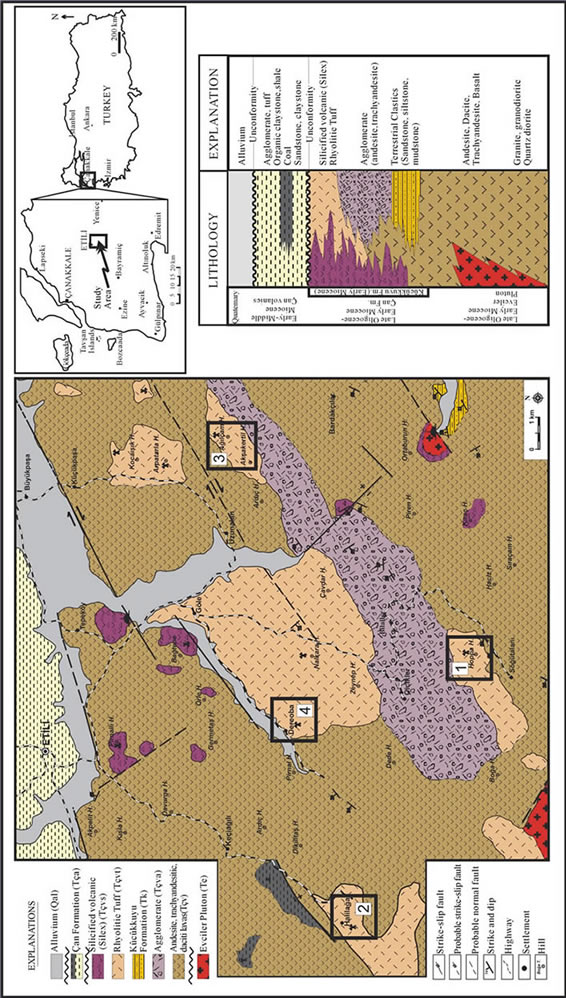
Figure 1. Geological map of the study area and stratigraphical columnar section (not to scale).
chanic experiments, as a result of which their characteristics as building stone or coating stones were overviewed. Rhyolitic tuffs of Çan volcanism in this study is also the first time in its effects on engineering properties of petrographic characteristics were investigated.
2. Material and Method
A geological map and stratigraphical section of the region was produced so that the diffusion and stratigraphical relationship between the rhyolitic tuffs located the south of Çan-Etili could be explored (Figure 1). Thin sections were produced from specimens collected during field research. The sections were then examined in detail under a polarizing microscope and their petrographical features were identified. In addition, specimens of 20 × 20 × 20 cm dimensions were taken from the quarries in 4 different areas (namely Hoppa Hill (1), Halilağa(2), Uzunalan(3), Dereoba(4)—Figure 1) where Çan stone (rhyolitic tuffs) were processed and subjected to standard rock mechanic experiments such as uniaxial compressive strength, unit weight, specific gravity, porosity and water absorption. Each experiment was conducted on at least three specimens and average of the obtained values was obtained. These experiments were conducted by preparing specimens of NX diameter core according to [17] in Middle East Technical University (METU) Department of Mining Engineering, Laboratory of Rock Mechanics. In order to determine the composition of the tuffs in the region in chemical terms, 9 samples taken from fresh specimens were sent to ALS Chemex (Canada) laboratory for major element analysis which was analyzed with ICP-AES.
3. Geological Features
The product of the magmatism where Çan stone (rhyolitic tuff) is widespread in the study area consists of granodioritic rocks and volcanic and volcanoclastic rocks of various compositions (Figure 1). Bedrocks of the study area constitute the Evciler Pluton which consists of Late Oligocene-Miocene [18] granite, granodiorite and quartz diorite. Main minerals included in the composition of the rocks that constitute this pluton are plagioclase, quartz, orthoclase, amphibole (hornblende) and biotite, whose patterns is one of holocrystalline, hypodiomorphic consisting of mediocre-large crystals. Granodioritic rocks found in this area are derivatives of calc-alkaline magma and are in harmony in terms of chemical composition with the volcanic rocks widely observed in the area. Volcanic rocks which cropped in the wide areas of the region are distinguished lava, agglomerates and tuffs in terms of lithostratigraphic. In addition, silica formation caused by hydrothermal solution in lava, agglomerate and tuff volcanic community is also common. Lavas are mostly in grey, greenish, reddish brown colors consist of andesitic, trachyandesitic and dacitic, generally massive and have joint and crack systems which are divided into thin layers here and there.
Main minerals of the widely-observed andesitic-composition lavas are plagioclase, biotite, hornblende and opaque minerals. Agglomerates are purplish burgundy colored volcanic products in the study area which consist of andesitic-dacitic composition rock particles. They can be easily identified in the field due to their color.
In addition, Küçükkuyu formation which consists of Early-Middle Miocene lake sediments [19] intruded with these volcanics and pyroclastics. Çan Formation which presents clay stone, sandstone, coal, organic shale, agglomerate and tuff stratigraphy [20] is in contradiction with the volcanic rock community which is widely observed in the region (Figure 1).
Tuffs which are the subject of this study have rhyolitic composition consist of the pyroclastic products in the study area and are widely found in the field. In this study they are separated from other volcanic units as lithological for the first time and their petrographical features are defined.
4. Petrographic and Geochemical Features of Tuffs
Rhyolitic tuffs which are found in the study area are easily identified among other volcanic rocks with their light yellowish, cream colors. Most important feature of these tuffs is the patterns created by iron oxides (hematization and limonite) which are developed by alteration (Figures 2(a) and (b)). They are easily identifiable in the area with this feature as well. In some Çan stone quarries, tuffs are observed massively; in some others, they are seen as separated and with multiple cracks towards their upper sec-
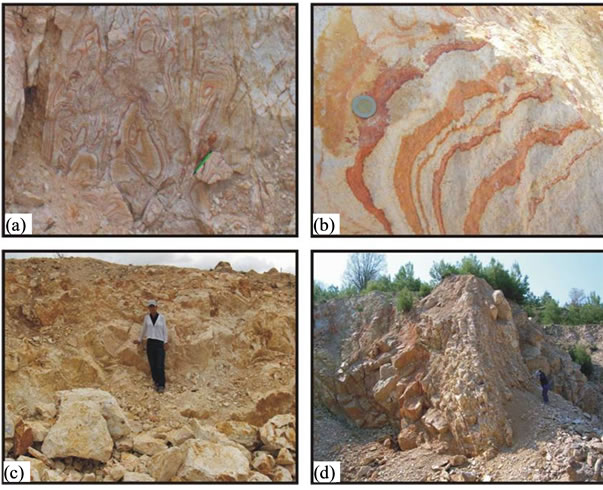
Figure 2. (a), (b) Patterns of iron oxide on tuffs; (c) Massive Çan stone quarry; (d) Decompose and joint systems of tuffs.
tion (Figures 2(c) and (d)). Tuffs display a compact structure with aphanitic texture in hand samples.
Petrographical examinations which were prepared thin sections were determined the textures and mineral compositions of samples. Samples for a description of each region are presented in Table 1. This can be seen from the table; Rhyolitic tuffs have similar petrographical properties. Their main minerals consist of quartz crystals, feldspar crystals, rarely biotite minerals, amphibole (hornblende) crystals and lithic fragments (Figures 3(a) and (b)), whose matrix is made of volcanic glass which is devitrified in some sections. Volcanic glass displays flowing texture in some areas, though not clear (Figures 3(c) and (d)). Some quartz crystals are formed during the formation of the rock, whereas some other are found as having replaced other minerals due to hydrothermal alteration. In almost all sections it is possible to find iron oxides developed as a result of alteration (Figure 3(e)). Examples show hypocrystalline, vitrophyric and/or vesicular texture (Figure 3(f)).

Table 1. Petrographical characteristics of Çan stone.
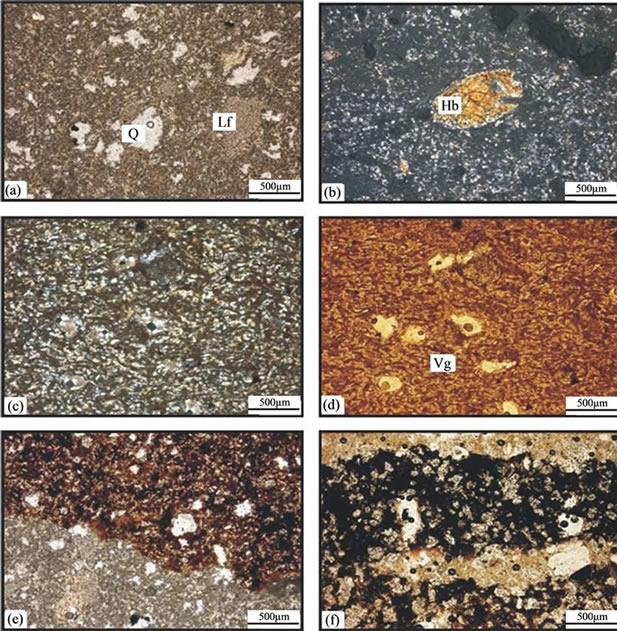
Figure 3. (a) Quartz and lithic fragments (xp); (b) Amphibole (hornblende) crystal (ppl); (c), (d) View of flowing texture on volcanic glass (ppl-xp); (e) Iron oxidation on tuffs; (f) Vesicular tuff (xp, cross-polarized light; ppl, plane-polarized light; Q, quartz; Lf, lithic fragment; Hb, hornblende; Vg, volcanic glass).
Major element analysis has been conducted in 9 samples of tuffs. Data belonging to these tuffs are presented in Table 2. Major element diagram are formed in order to be able to determine the composition of tuffs taking their petrographical features into consideration. In total alkali-silica diagram ((Na2O-K2O)-SiO2) in Figure 4, it is seen that all samples are located in rhyolitic area.
5. Mechanical and Physical Features of Tuffs
Çan stone in the region are generally used as outside covering stone, decorative stone and fireplace stone (Figures 5(a)-(c)) for many years. Determination of the mechanical and physical features of these tuffs which are used as building stone, coating stones and decorative stones bear huge importance in the selection of usage area. In this paper, Çan stone tuffs found in Hoppa Hill-HT (1), Halilağa-HA (2), Uzunalan-UA (3) and Dereoba-DO (4), where quays are found in the study area. Various laboratory tests were carried out on the core specimens prepared from block samples to determine physical and mechanical properties of Çan stone. These tests comprised the determination of unit weight (UW), specific gravity, porosity (P), water absorption (WA), uniaxial compressive strength (UCS) and were carried out on at least three samples. Their average values are presented in Table 3 as compared with similar tuff and ignimbrite samples in use in some parts of Turkey.
Besides, one important factor in economic evaluation of Çan stone is the patterns created by iron oxide traces (Figure 5(d)). [22] suggest to the formation mechanisms of these patterns that aggregations of secondary pyrite minerals were altered into iron oxide (hematite, limonite) due to the volcanic gases which circulated within the fault and fracture systems.
Correlation between UCS and WA, P, UW are shown in Figures 6-8. Figure 9 indicate the relationship between P and WA. Besides, interrelationships between petrographical characteristics and engineering properties of tuffs are plotted to make a correlation. Figures 10, 11 provide the relationship between UCS and SiO2 and K2O.
Looking at these graphs, the amount of SiO2 which mostly showing the presence of quartz minerals in tuffs is increasing in direct to the UCS due to a very high strength proportion. If the graph between the UCS and K2O, UCS decreases with increasing K2O ratio. The reason for this is thought that feldspar minerals in tuffs easily altered by clay minerals. Therefore, the value of the UCS can be said that decrease in rock that increase of clay minerals. In addition to, Çan stones not dispersed by the firing experiments at temperatures about 1175˚C and 7.48% is observed a contraction [22]. These tuffs are used in fireplaces show the fire and heat strength of their.

Table 2. Major element (weight%) analyses of the Çan stone.

Figure 4. Total alkali (Na2O + K2O) versus SiO2 (wt%) [21] plotted of the Çan stone (R; Rhyolite).
6. Discussion and Conclusions
Detailed geological studies conducted in the area and tuffs found in a vast area in the south of Çan-Etili constitute the pyroclastic last products of volcanism developed in the area. They are stratigraphically located on lava and agglomerate which are other members of volcanism. Petrographical properties of Çan stone show that consist of well-merged rock particles in a glassy matrix which is partially devitrified and quartz, plagioclase, biotite and amphibole (hornblende) minerals. They have rhyolitic composition.
The maximum value per unit weight as a result of experiments Çan stone samples were obtained Hoppa Hill (Table 3). This is because both the rock forming minerals (opaque minerals, especially) and the presence of lithic fragments is thought to be the impact on unit weights. However, the porosity and opaque minerals in samples of Uzunalan reduces the value of unit weight

Figure 5. (a) Usage of Çan stone as outside covering stone; (b) Decorative stone; (c) Fireplace stone; (d) The patterns created by iron oxide traces.
less of the rock.
When the porosity and relevant water absorption situation of the specimens are examined, it can be seen that this situation is in direct proportion with Hoppa Hill and Uzunalan specimens. Uzunalan samples with highest porosity have water absorption rate by weight is highest, while Hoppa Hill samples with the lowest porosity values represent a water absorption rate is lowest (Table 3).

Table 3. Average values of Çan Stone with similar stone examples in Turkey.

Figure 6. The graphs between Uniaxial compressive strength (UCS) and Water absorption (WA).

Figure 7. The graphs between Uniaxial compressive strength (UCS) and Porosity (P).
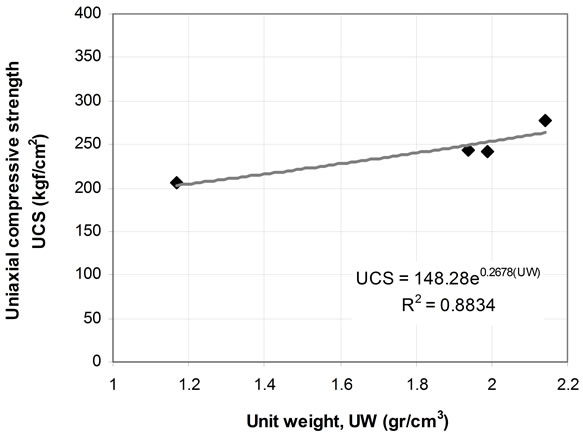
Figure 8. The graphs between Uniaxial compressive strength (UCS) and Unit weight (UW).

Figure 9. The graphs between Porosity (P) and Water absorption (WA).

Figure 10. The graphs between Uniaxial compressive strength (UCS) and SiO2.
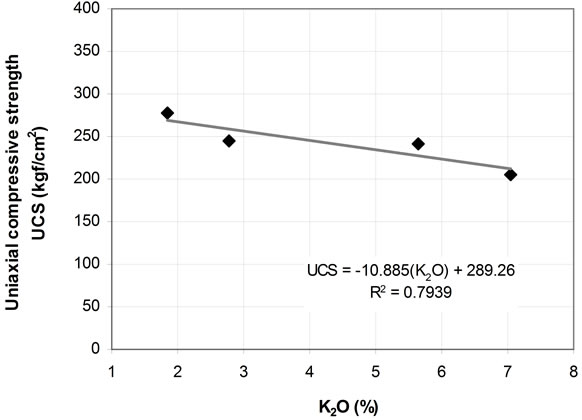
Figure 11. The graphs between Uniaxial compressive strength (UCS) and K2O.
Correlations between physical and mechanical properties of Çan stone were examined using simple regression analysis. The testing results have been show that there were found good correlations between UCS-WA, UCS-P, UCS-UW, P-WA. As can be seen from the Figure 6-9, UCS decreases with increasing WA (Figure 6), P (Figure 7) whereas increasing UCS increases UW (Figure 8) and WA increases with increasing P (Figure 9). As acon sequence of these comparisons, UCS was found to follow a decreasing polynomial relation with WA and P, and an increasing polynomial relation with UW. Also WA has an increasing polynomial relation with P (Figure 10).
When petrographical and chemical features and engineering features of Çan stone are compared, some interaction has been identified. The amount of rock fragments which filled between particles and matrix, the vacancy rate and excess of glass particles increases the compressive strength. Correlations between mechanical and geochemical properties have been shown that there were found good correlations between UCS-SiO2 and UCSK2O (Figures 10, 11).
Çan stone which can be easily cut and processed, also features color and engineering play an important role in use of their as covering stone and decorative stone.
7. Acknowledgements
This study was financially supported by The Scientific and Technological Research Council of Turkey (TUBITAK, Project No. 105Y114)
REFERENCES
- Y. Yılmaz, “An Approach to the Origin of Young Volcanic Rocks of Western Turkey,” In: A. M. C. Şengör Ed., Tectonic Evolution of the Tethyan Region, Kliwer, Hague, 1989, pp. 159-189.
- Y. Yılmaz, “Comparisons of the Young Volcanic Associations of the West and the East Anatolia under the Compressional Regime: A Review,” Journal of Volcanology and Geothermal Research, Vol. 44, No. 1-2, 1990, pp. 69-87. doi:10.1016/0377-0273(90)90012-5
- Y. Yılmaz, Ş. C. Genç, Z. Karacık and Ş. Altunkaynak, “Two Contrasting Magmatic Associations of NW Anatolia and Their Tectonic Significance,” Journal of Geodynamics, Vol. 31, No. 3, 2001, pp. 243-271. doi:10.1016/S0264-3707(01)00002-3
- O. Ertürk, E. Dinçöz and D. Alaygut, “Petrology of the Cenozoic Volcanics in the Biga Peninsula,” International Earth Saences Congress on Aegean Region Proceedings, II, NW Turkey, 1990, pp. 368-384.
- T. Ercan, M. Satır, G. Steinitz, A. Dora, E. Sarıfakıoglu, C. Adis, H. J. Walter and T. Yıldırım, “Biga Yarımadası ile Gökçeada, Bozcaada ve Tavşan Adalarındaki KB Anadolu Tersiyer Volkanizmasının özellikleri (in Turkish),” MTA Dergisi, Vol. 117, 1995, pp. 55-86.
- E. Aldanmaz, J. Pearce, M. F. Thriwall, J. Mitchell, “Petrogenetic Evolution of Late Cenozoic, Post-Collison Volcanism in Western Anatolia, Turkey,” Journal of Volcanology and Geothermal Research, Vol. 102, No. 1-2, 2000, pp. 67-95. doi:10.1016/S0377-0273(00)00182-7
- Ş. C. Genç, M. Dönmez, A. Akçay and Ş. Altunkaynak, “The Middle Eocene to Late Miocene Magmatic Evolution of the Biga Peninsula, NW Turkey,” 32nd International Geological Congress, Florence, 20-28 August 2004, p. 1298.
- Ş. Altunkaynak and Y. Dilek, “Timing and Nature of Postcollisional Volcanism in Western Anatolia and Geodynamic Implications,” In: Y. Dilek and S. Pavlides, Eds., Post Collisional Tectonics and Magmatism in the Mediterranean Region and Asia, Geological Society of America Special Paper, Vol. 409, 2006, pp. 321-351.
- Y. Dilek and Ş. Altunkaynak, “Cenozoic Crustal Evolution and Mantle Dynamics of Post-Collisional Magmatism in Western Anatolia,” International Geology Review, Vol. 49, No. 5, 2007, pp. 431-453. doi:10.2747/0020-6814.49.5.431
- Ş. Altunkaynak and Ş. C. Genç, “Petrogenesis and TimeProgressive Evolution of the Cenozoic Continental Volcanism in the Biga Peninsula, NW Anatolia (Turkey),” Lithos, Vol. 102, No. 1-2, 2008, pp. 316-340. doi:10.1016/j.lithos.2007.06.003
- Y. Yılmaz, “Ege Bölgesinde Genç Magmatizmanın Olu- şumu ile Litosferin Evrimi Arasındaki Ilişki Üzerine Düşünceler (in Turkish),” Jeofizik, Vol. 9, No. 10, 1995, pp. 107-110.
- N. Köprübaşı and E. Aldanmaz, “Geochemical Constraints on the Petrogenesis of Cenozoic I-Type Granitoids in Northwest Anatolia, Turkey: Evidence for Magma Generation by Lithospheric Delamination in a Post-Collisional Setting,” International Geology Review, Vol. 46, No. 8, 2004, pp. 705-729. doi:10.2747/0020-6814.46.8.705
- T. Ercan, M. Satır, H. Kreuzer, A. Türkecan, E. Günay, A. Çevikbaş, M. Ateş and B. Can, “Interpretation of New Chemical, Isotopic and Radiometric Data on Cenozoic Volcanics of Western Anatolia,” Bulletin of the Geological Society of Turkey, Vol. 28, 1985, pp. 121-136.
- E. Aldanmaz, N. Koprubası, O. F. Gurer, N. Kaymakcı and A. Gourgaud, “Geochemical Constraints on the Cenozoic, OIB-Type Alkaline Volcanic Rocks of NW Turkey: Implications for Mantle Sources and Melting Processes,” Lithos, Vol. 86, No. 1-2, 2006, pp. 50-76.
- N. Güleç, “Crust-Mantle Interaction in Western Turkey: Implications from Sr to Nd Isotope Geochemistry of Tertiary and Quaternary Volcanics,” Geological Magazine, Vol. 128, No. 5, 1991, pp. 417-435.
- Ş. Altunkaynak, “Collision-Driven Slab Breakoff Magmatism in Northwestern Anatolia,” Journal of Geology, Vol. 115, No. 1, 2007, pp. 63-82.
- TS 699, Doğal Yapı Taşları-İnceleme ve Laboratuvar Deney Yöntemleri, Türk Standardları Enstitüsü (TSE) (in Turkish), Ankara, 2009.
- P. Birkle and M. Satır, “Dating, Geochemistry and Geodynamic Significance of the Tertiary Magmatism of the Biga Peninsula, NW-Turkey, Geology of the Black Sea Region,” Mineral Research and Exploration Institute of Turkey, Ankara, 1995, pp. 171-180.
- N. B. Çiftçi, R, Ö. Temel and M. N. Terzioğlu, “Neogene Stratigraphy and Hydrocarbon System of the Region Surrounding the Gulf of Edremit, NW Anatolia, Turkey,” TPJD Bulletin, Vol. 16, No. 2, 2004, pp. 81-104.
- M. Siyako, K. A. Burkan and A. I. ve Okay, “Biga ve Gelibolu Yarımadaları Tersiyer Jeolojisi ve Hidrokarbon olanakları,” Turkish Association of Petroleum Geologist Bulletin, Vol. 1, 1989, pp. 183-199.
- M. J. Le Bas, R. W. Le Maitre, A. Streckeisen and B. Zanettin, “A Chemical Classification of Volcanic Rocks Based on the Total Alkali-Silica Diagram,” Journal of. Petrology, Vol. 27, No. 3, 1986, pp. 445-450.
- H. Akdaş, M. R. Bozkurt and T. Dıkduran, “Çantaşı- Desenli Yapıtaşı (in Turkish): Turkey III,” Marble Symposium Proceedings, Turkey, 2001, pp. 153-162.
- O. Şimşek and M. Erdal, “Investigation of Some Mechanical and Physical Properties of the Ahlat Stone (Ignimbrite) (in Turkish),” Journal of Science, Vol. 17, No. 4, 2004, pp. 71-78.
- M. Korkanç, “The Effect of Geomechanical Properties of İgnimbrites on Their Usage as Building Stone: Nevşehir Stone (in Turkish),” Geological Engineering, Vol. 31, No. 1, 2007, pp. 49-60.
- E. Yasar, A. Tolgay and A. Teymen, “Industrial Usage of Nevsehir-Kayseri (Turkey) Tuff Stone,” World Applied Sciences Journal, Vol. 7, No. 3, 2009, pp. 271-284.

